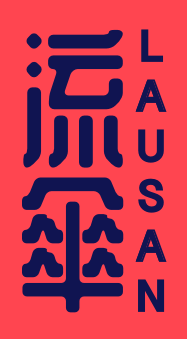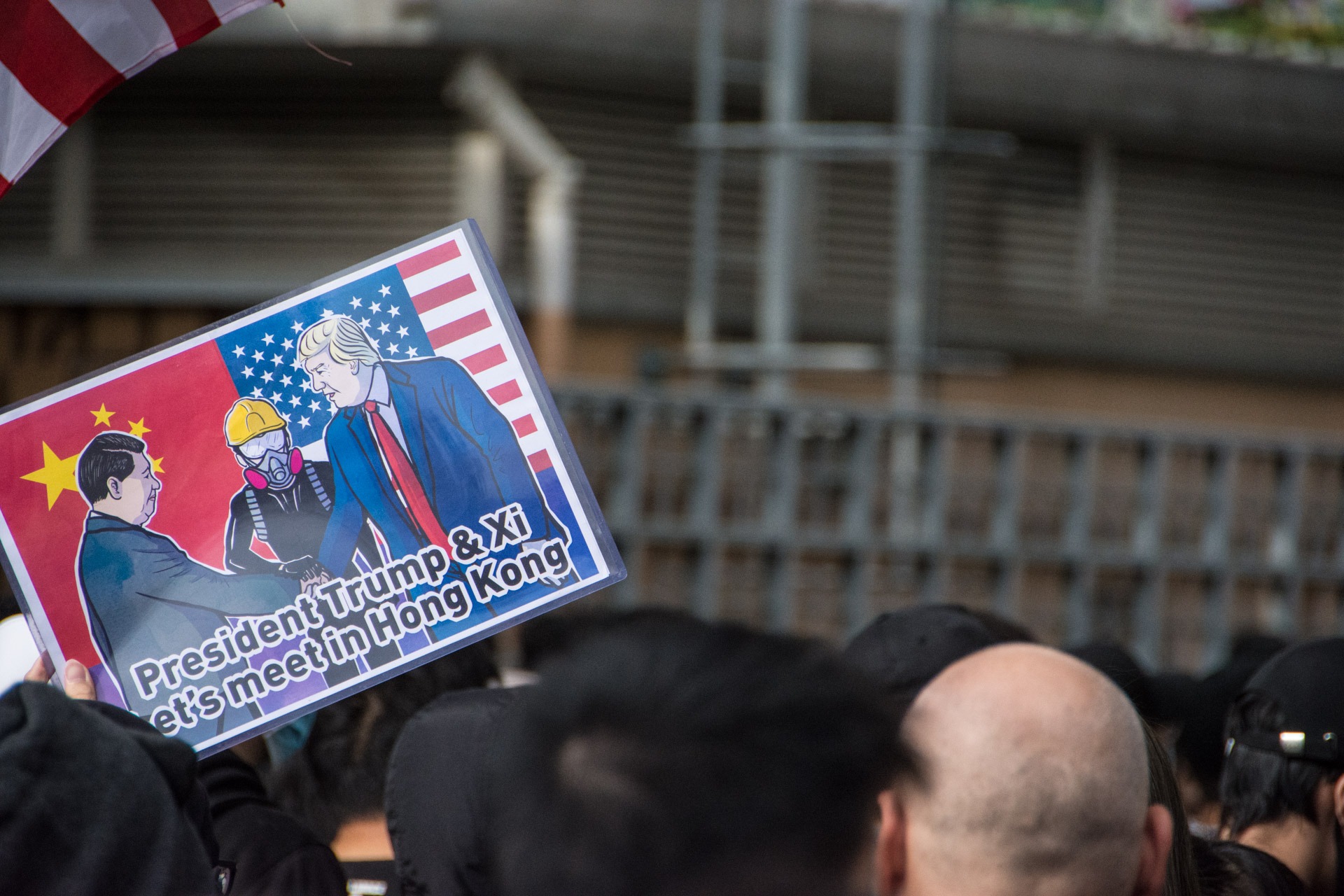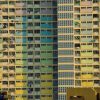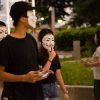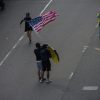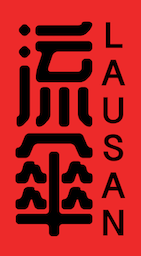The author would like to thank JS, first and foremost, for generative and substantive edits over several drafts, alongside yehua, Wilfred Chan, Sophia Chan, Hung X. L., and LWH. Many of the best insights in this piece can be directly attributed to Listen Chen’s incisive comments. R, JN, and Au Loong-yu have been speaking out against right-wing elements in the Hong Kong movement; this essay is directly inspired by their perspicacity and resolve.
Read this article in Chinese.
In the early 2000s, over 30% of people living in Hong Kong identified as Chinese; today, that number has plummeted to only 10%—according to a University of Hong Kong survey—with more than half of Hong Kong’s residents identifying instead as a “Hongkonger.” For many in Hong Kong, the consolidation of this identity can be a unifying force that can lead to emancipatory demands for self-determination. But with so many people choosing not to identify as “Chinese”, this shift could also indicate a rise in anti-mainland xenophobia.
While the most virulent strands of anti-mainland sentiment remain marginal in Hong Kong, we still saw a disturbing pattern of harassment and even violence directed at mainland Chinese people during the anti-establishment movement in 2019. These attacks were no accidents: For the past several years, this bigoted sentiment was stoked by an increasingly organized group of right-wing localists.
Localism, a broad array of ideological tendencies promoting local interests, often finds its most confrontational and identitarian expression in nativism, which portrays Hongkongers as inherently superior to mainlanders. After the failure of the 2014 Umbrella Movement, when many Hongkongers lost faith in non-violent, civil dissent, nativism was seen as an alternative and has since enjoyed a surge in popularity.
Right-wing localists have pointed their finger at Chinese encroachment, calling it the primary cause of Hong Kong’s political woes.
While localism itself remains a highly slippery term, signaling anything from Joshua Wong-led Demosisto’s “democratic self-determination” to the recently formed Hong Kong National Party’s advocacy for total independence from Chinese rule, a distinctively exclusionary and right-wing brand of localism has blossomed in recent years. Since then, right-wing localists have also demonized Hong Kong’s political “left” (which encompasses liberal democrats, progressives, and the radical left) and blamed them for the failure of the Umbrella Movement.
With worsening economic conditions and the continued erosion of Hongkongers’ civil liberties, right-wing localists have pointed their finger at Chinese encroachment, calling it the primary cause of Hong Kong’s political woes. More than anyone else, Chin Wan (陳雲) sits at the center of all this.
Chin Wan’s anti-mainland influence
Born in Hong Kong to Malaysian immigrants, Chin Wan obtained his PhD in ethnology in Germany, and worked in various government bureaus, like the Home Affairs Bureau, before joining the faculty of Hong Kong’s Lingnan University in 2009. In 2011, he wrote a best-selling book On the Hong Kong City-State (《 香港城邦論 》), which became the intellectual road-map for a new generation of pro-independence localist leaders.
Since his book’s appearance, anti-mainland groups like Hong Kong Indigenous, Hong Kong Autonomy Action (HKAA), Youngspiration, Hong Kong National Party, and Civic Passion began appearing in Hong Kong’s political sphere. Building off Chin’s writing, these groups have openly blamed mainlanders as the source of Hong Kong’s economic woes, portraying them as a threat to Hongkongers’ cultural heritage. But while the membership of these groups remains small, their scapegoating of mainland immigrants has reached a much wider audience.
Chin’s book is packed with anti-immigrant arguments that would find a home in Western right-wing movements. One example is Chin’s attitude about pregnant women emigrating from the mainland, who he denigrates for taking advantage of the city’s welfare provisions and using resources that should be reserved for “local” Hongkongers. But in reality, the Hong Kong-based NGO Society for Community Organisation reports that only five percent of mainland immigrants receive social security, and 70 percent of them occupy low-income jobs that are left unfilled by local Hongkongers.
[Chin] argues for exclusionary policies directed towards mainland immigrants to distract from the real culprits of Hong Kong’s economic precarity: rich tycoons like Hong Kong’s Li Ka-Shing and capitalist elites from mainland China.
Chin further argues that mainlanders’ repeated “abuse” of Hongkongers’ resources have rightfully triggered a defensive “Hong Kong ethnic consciousness” that have imbued Hongkongers with their own set of “cultural values” distinct from and superior to those of the mainland.[1] This is purportedly the basis of “Hong Kong identity”, and for Chin, mainlanders are only welcome to the city if they assimilate and do not “nibble away (蠶食)” at Hong Kong’s civilized values.
Rich mainland immigrants are the exception. Like the way Trump peddles anti-immigrant rhetoric while expanding EB-5 visas to accommodate wealthy immigrants, Chin writes: “We welcome wealthy Chinese immigrants to Hong Kong, and Hong Kong should welcome them to bring their wealth and capital to our city.”[2]
Chin also criticizes the “one-way permit scheme” (單程證), which allows a daily quota of 150 mainland immigrants to resettle in Hong Kong for family-related purposes. To hamper immigration from the mainland, he argues that Hong Kong must take back control over who to allow entry to (來港審批權), which, through the Hong Kong government, is currently administered by the Chinese Communist Party (CCP). But while the scheme is indicative of the deeper structural problems around migration in China, Chin’s opposition is rooted in xenophobia and classism, arguing merely for local Hongkongers’ right to have a say over the scheme while failing to address the underlying forces that compel mainlanders to migrate in the first place.
Chin is consistent in the way he takes advantage of Hongkongers’ anxiety over worsening economic conditions by blaming mainland immigrants for dragging the economy down. He argues for exclusionary policies directed towards mainland immigrants to distract from the real culprits of Hong Kong’s economic precarity: rich tycoons like Hong Kong’s Li Ka-Shing and capitalist elites from mainland China.
The Hong Kong ‘city-state’ is for the rich
In an attempt to reclaim “authentic” Chineseness, Chin’s sequel to his 2011 book characterizes Hong Kong as the heir of a vaguely-defined “Huaxia” (華夏) heritage.[3] Citing Hong Kong’s use of traditional Chinese instead of simplified Chinese, which is used in mainland China, Chin explains that Hong Kong’s Huaxia heritage aligns more closely with “traditional” Chinese values.
But for him, this heritage alone is not enough. Instead, he attributes Hong Kong’s cultural and economic success to the unique integration of both Huaxia and British values, symbolized in the colonial-era Dragon-Lion flag.
This idea comes from his characterization of Hong Kong as a “city-state,” modeled after those of classical and early modern Europe. According to Chin, this means Hong Kong must be “autonomous” and have “independent sovereignty,” yet rely on an “imperial power” for military protection, diplomatic leadership and trade, hence the mixture of Huaxia and British “values.” [4]
Chin’s analysis supports a common localist myth that is shared among lower- to middle-class protesters: That they have more in common with tycoons like Li Ka-Shing than fellow workers in the mainland.
Chin writes that the key is to “ally with foreign powers, and establish civic trust and rule of law to win the trust of global powers.” [5] The British, as Chin narrates, developed Hong Kong into a robust city-state under its aegis. But now that they’ve relinquished control, Chin’s mission is to court the US empire as Hong Kong’s new imperial protector to fend against an encroaching China. Under this model, Hong Kong may even be able to lead the rest of China into “restoration”; but first, it must defend itself from “backward” mainland values.
However, Chin fails to mention that city-states were by no means democratic societies that guaranteed the rights of all. They could only operate because of an exploited army of cheap laborers or slaves. Only the ruling aristocracy were given democratic rights and allowed to participate in civil discourse. In other words, these rights-bearing citizens could only exist because of an underclass of non-citizens.
In a similar vein, Chin does not account for how the British restructured Hong Kong’s economy to create a small group of white and Chinese elites while preserving a large working-class base. His analysis not only obscures these elites’ active participation in exacerbating Hong Kong’s inequality, but convinces a new and expanding generation of precarious young workers that they can access the same economic privileges as well. In other words, Chin’s analysis supports a common localist myth that is shared among lower- to middle-class protesters: That they have more in common with tycoons like Li Ka-Shing than fellow workers in the mainland.
Contrary to Chin’s beliefs, many of Hong Kong’s best social protections did not come from incorporating “Western values.” Instead, they were the results of hard-fought concessions won from working-class opposition against colonial rule. One example was when students and tenants rioted over the colonial government’s rejection of Chinese aid for fire victims in the wake of the 1951 Tung Tau fire, one of the countless squatter fires throughout the 1950s which included the infamous 1953 Shek Kip Mei fire.[6] These working-class struggles, including the later 1967 riots, eventually compelled the colonial government to commit to a series of developmental programs to stabilize the populace, such as Murray MacLehose’s Ten-year Housing Programme to develop more public housing. The creation of the Independent Commission Against Corruption (ICAC), which exists to this day, was also established as a result of activists who protested the 1974 bribery scandal of senior Royal Hong Kong Police officer Peter Godber, who held over HKD 4.4 million in overseas accounts.
Chin’s focus on ethnonationalism instead of class allows him to exploit the growing inequality in Hong Kong. As the city’s wealth gap continues to deepen, more people are stuck with precarious jobs, de-classed, and have no prospect of owning property. Chin’s theories appeal precisely to this demographic, which is incidentally a major pool of his localist supporters.[7] Instead of blaming the rich, this group identifies with the privileged “Hong Kong identity” that Chin champions, even though it materially applies to fewer and fewer of them. In reality, their material conditions render them closer to those who are excluded or even demonized in his writing.
Of course, some Hong Kong protesters recognize that their city’s problems lie beyond the CCP’s encroachment of civil liberties. A recent anonymous post on a Telegram channel illustrates this:
“A fifth of our population can barely afford two meals a day, survive on government benefits, and live in subdivided flats; some aimlessly going through life unable to find a job … Hong Kong has [one of] the highest Gini coefficient of all cities in the world, the most severe wage gap, the most expensive housing market … This is Hong Kong: an international and financial hub, heaven for the rich, hell for the others.”
Hongkongers are already living in the bleak reality of Chin’s “Huaxia-Western” ideal: a city limited by its own contradictions, whose identification with the West masks its own ongoing economic decay.
An attack on international solidarity
Chin’s belief that Hong Kong needs a Western savior had bled into last year’s anti-establishment protests. While vastly over-represented by both Chinese and Western media, right-wing localists have repeatedly joined protests wielding US flags and pleaded for Western intervention. But this did not sit well with many activists around the world watching the Hong Kong movement unfold. With countless nations that have fallen victim to the reckless and self-serving foreign policy of the US, courting US intervention only sets Hong Kong on a path that could preclude meaningful solidarity from other mass movements around the world.
What right-wing localists see as realpolitik—stoking ethnonationalism and inviting US intervention—is instead driving a wedge between Hong Kong’s movement and the countless others happening around the world. This persistent minority of protesters led by groups like HKAA rely on corrupt and warmongering politicians like Marco Rubio, whose support for the Saudi Arabian-led aggression in Yemen and the Iraq War led to countless civilian deaths. In fact, the US has a track record of denying people’s rights, supporting authoritarian military coups, and undermining genuine democracies—all under the banner of “freedom.”
This is why the Hong Kong Human Rights and Democracy Act was met with skepticism from activists around the world. While its passage may symbolize American support, it is no secret that the US political elites do not genuinely have the interests of Hongkongers at heart. Just like the history of the British before them, the history of US intervention is marked by betrayal and human rights abuses, from rescinding its support in Rojava last year to assisting the Suharto administration in murdering over one million political opponents in 1960s Indonesia.
No one knows better than Beijing that Hong Kong solidarity with mainland workers has transformative potential.
Furthermore, right-wing localists’ anti-Chinese and pro-US stance flattens the conflict into a contest between Beijing’s authoritarianism and Western freedom, and glorifies the Hong Kong movement as civil society’s last line of defense against the menacing CCP.
Perhaps the most important alliance that Chin undermines is with the mainland Chinese working-class. “We are not only fighting for Hongkongers’ democratic rights but also supporting those of the mainland,” wrote the long-time Hong Kong-based labor activist Au Loong-yu in an early critique of Chin. “It would not be easy to build alliances with the Chinese working-class, but this strategy is much smarter than making an enemy out of them.”
Like activists in Hong Kong, mainland workers have had ample experience organizing en masse against local government and the brutal working conditions in countless factories. In 2018 alone, China Labour Bulletin recorded over 1700 labor-related protests. While Chin and his US-flag waving followers were worshiping Hong Kong’s white colonizers on social media, citizens in Wenlou, China were shooting fireworks at the police to protest a local construction project.
No one knows better than Beijing that Hong Kong solidarity with mainland workers has transformative potential—that the movement could spread like wildfire if it connected with the volatile labor movement in the mainland. This explains Beijing’s thorough smear campaign against the Hong Kong protesters in the mainland.
Redefining ‘the local’ in localism
Chin’s writing has fomented a dangerous right-wing tendency within this movement. With the outbreak of the coronavirus, anti-mainland sentiment is on the rise, and Chin’s advocacy of exclusionary politics is ripe for adoption. But in order to build a sustainable and broad-based movement, Hongkongers have to challenge the contradictions of Chin’s backward politics of identity-based exclusion.
One way is to build solidarity with marginalized groups who are less visible in Hong Kong’s social movements, such as the housewives and migrant domestic workers who have taken on issues like gendered division of labor and accessibility. The deportation of Yuli Riswati, an Indonesian domestic migrant worker, is an example that resulted in a series of solidarity actions with marginalized communities in Hong Kong.
The movement’s recent turn to labor organizing and unionization is another example that stresses solidarity beyond class and ethnic boundaries. With help from the pro-democracy Hong Kong Confederation of Trade Unions (HKCTU) and smaller leftist groups like Workers Committee, workers from over 70 different sectors have formed new unions in the past several months, marking the first time in the city’s recent history where workers across different sectors have held sustained interest in organized labor power.
If Hong Kong protestors want to fundamentally transform their society into a fairer and more democratic one, they must continue developing strategies that not only benefit those who fit into the narrow conception of a “Hongkonger,” but everyone living in Hong Kong society. Perhaps then can the slippages of “localism” turn against Chin’s favor: by redefining “the local,” not as an exclusionary term, but one that ensures political and economic rights for all Hongkongers.
Footnotes
[1] Chin Wan, Hong Kong City-state Theory (Hong Kong: Enrich Publishing, 2011), 150.
[2] Ibid., 158.
[3] ‘Huaxia’ is a historical term that denotes some form of common ethno-cultural root among Han Chinese people, used here to indicate authentic Chinese culture.
[4] Ibid., 67.
[5] Ibid.
[6] Alan Smart, The Shek Kip Mei Myth: Squatters, Fires and Colonial Rule in Hong Kong, 1950-1963 (Hong Kong: Hong Kong University Press, 2006), 76-77.
[7] I thank Listen Chen for this insight.
